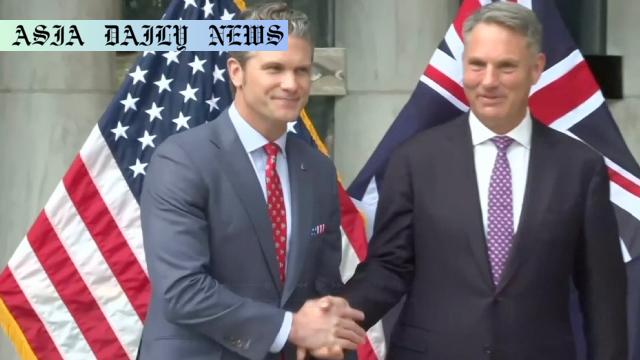Defense Spending: US Defense Secretary Hegseth urges Australia to increase its defense expenditure to 3.5% of GDP immediately.

US Calls for Increased Australian Defense Spending
The United States has made a strong appeal to Australia for a significant hike in its defense budget. US Defense Secretary Pete Hegseth urged Canberra to increase its defense spending to 3.5% of GDP during a meeting with Richard Marles, Australia’s Defense Minister, on the sidelines of the Shangri-La Dialogue in Singapore. This appeal comes amid growing regional concerns tied to security challenges in the Indo-Pacific. Despite the significance of the request, Australia has responded with a measure of caution, showcasing a disparity in defense priorities between the two allies.
Australia’s Muted Response to US Request
While the US has reiterated the need for a substantial defense budget boost, Australia’s reaction has been markedly reserved. Prime Minister Anthony Albanese emphasized that defense funding decisions need to be thoughtfully planned. He argued that the government would not commit to a specific figure without clearer alignment with strategic goals. Albanese remarked, “What we need is things that defend us in real terms, and that’s what we’ll provide.” Australian authorities suggest a more measured increase to 2.4% over the next decade, reflecting a cautious approach compared to Washington’s aggressive demand.
Strategic Defense in a Transforming Global Landscape
The US perspective is deeply rooted in evolving global security dynamics. As tensions rise in the Indo-Pacific due to China’s muscular foreign policy and military assertiveness, Washington seeks to solidify alliances in the region. Australia, a key strategic partner, remains an important component of this defense strategy. Analysts view the US proposal as a recognition that robust defense spending is essential in countering emerging threats. However, from Australia’s perspective, significant increases must carefully weigh the balance of economic, political, and military considerations.
Australia’s Economic Constraints and the Path Forward
Aspending commitment of 3.5% of GDP would place a considerable strain on Australia’s economy, raising concerns about sustainability. The Albanese government has indicated that such a commitment would require careful financial reshuffling, including potential cuts to other social programs or increased borrowing. In contrast, the US, which spends approximately 3.5% of its own GDP on defense, views this benchmark as necessary to safeguard global order. The debate highlights larger questions about the evolution of defense funding within an interconnected global economy.
The Geopolitical Importance of Australian-US Relations
The conversation around defense spending underscores the broader geopolitical significance of the Australian-US alliance. Both nations have a vested interest in ensuring stability in the Indo-Pacific, which remains at the heart of many global challenges today. Through forums like the Shangri-La Dialogue, countries exchange ideas on managing security threats and defending shared interests. As military alliances become increasingly important in addressing evolving complexities, balancing national priorities with global responsibilities will remain a delicate dance for Australia.
Commentary
The Strategic Rationale Behind Increased Defense Spending
The call by US Defense Secretary Pete Hegseth for Australia to raise its defense spending to 3.5% of GDP reflects the growing importance of alliances in today’s global security environment. As the Indo-Pacific faces heightened geopolitical tensions, Washington sees Australia as a critical partner in countering potential threats. Encouraging Australia to expand its defense budget aligns with America’s broader strategy to strengthen its allies’ military capabilities and maintain an edge in this volatile region.
Economic Challenges and Policy Considerations
Though the US stance is understandable from a strategic perspective, the practical challenges for Australia are significant. Unlike the US, with its vast economy and global military reach, Australia operates on a comparatively smaller economic scale. A rapid leap from the current 2% GDP spending on defense to 3.5% could place immense pressure on the nation’s budget. It would also raise tough questions about trade-offs with other critical sectors such as healthcare, education, and infrastructure development. The Albanese government’s cautious approach to this issue deserves recognition for seeking to balance economic sustainability with strategic commitments.
The Need for Thoughtful and Collaborative Decision-Making
This debate ultimately highlights the complexity of global security in the 21st century. While allied cooperation remains fundamental, each nation must take into account its own domestic realities. Australia’s stance indicates it values practical solutions over symbolic gestures, ensuring there’s clarity about where the money is allocated and how it serves its broader strategic purposes. With continued dialogue, the US and Australia can likely find common ground that balances their shared interests while respecting their unique priorities.


